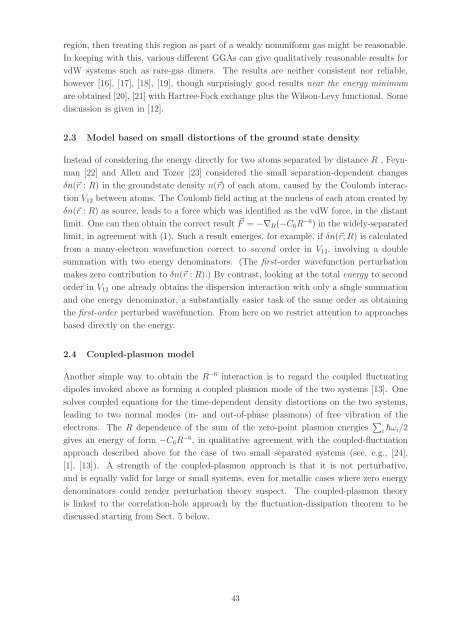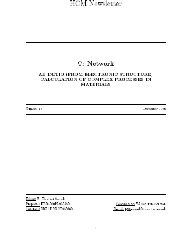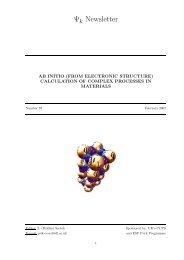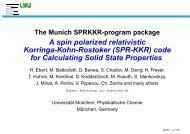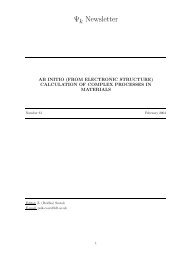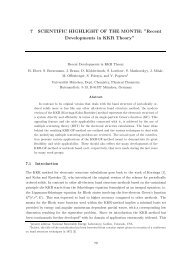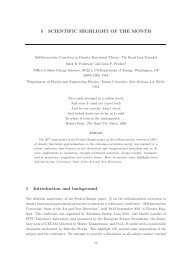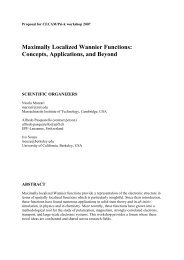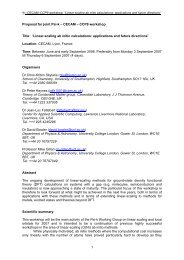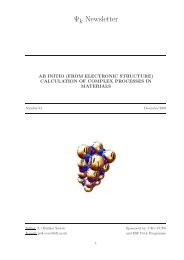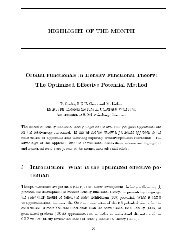Newsletter 107 - October 2011 - (pdf - 0.6 MB) - Psi-k
Newsletter 107 - October 2011 - (pdf - 0.6 MB) - Psi-k
Newsletter 107 - October 2011 - (pdf - 0.6 MB) - Psi-k
You also want an ePaper? Increase the reach of your titles
YUMPU automatically turns print PDFs into web optimized ePapers that Google loves.
egion, then treating this region as part of a weakly nonuniform gas might be reasonable.<br />
In keeping with this, various different GGAs can give qualitatively reasonable results for<br />
vdW systems such as rare-gas dimers. The results are neither consistent nor reliable,<br />
however [16], [17], [18], [19], though surprisingly good results near the energy minimum<br />
are obtained [20], [21] with Hartree-Fock exchange plus the Wilson-Levy functional. Some<br />
discussion is given in [12].<br />
2.3 Model based on small distortions of the ground state density<br />
Instead of considering the energy directly for two atoms separated by distance R , Feynman<br />
[22] and Allen and Tozer [23] considered the small separation-dependent changes<br />
δn(⃗r : R) in the groundstate density n(⃗r) of each atom, caused by the Coulomb interaction<br />
V 12 between atoms. The Coulomb field acting at the nucleus of each atom created by<br />
δn(⃗r : R) as source, leads to a force which was identified as the vdW force, in the distant<br />
limit. One can then obtain the correct result ⃗ F = −∇ R (−C 6 R −6 ) in the widely-separated<br />
limit, in agreement with (1). Such a result emerges, for example, if δn(⃗r; R) is calculated<br />
from a many-electron wavefunction correct to second order in V 12 , involving a double<br />
summation with two energy denominators. (The first-order wavefunction perturbation<br />
makes zero contribution to δn(⃗r : R).) By contrast, looking at the total energy to second<br />
order in V 12 one already obtains the dispersion interaction with only a single summation<br />
and one energy denominator, a substantially easier task of the same order as obtaining<br />
the first-order perturbed wavefunction. From here on we restrict attention to approaches<br />
based directly on the energy.<br />
2.4 Coupled-plasmon model<br />
Another simple way to obtain the R −6 interaction is to regard the coupled fluctuating<br />
dipoles invoked above as forming a coupled plasmon mode of the two systems [13]. One<br />
solves coupled equations for the time-dependent density distortions on the two systems,<br />
leading to two normal modes (in- and out-of-phase plasmons) of free vibration of the<br />
electrons. The R dependence of the sum of the zero-point plasmon energies ∑ i ω i/2<br />
gives an energy of form −C 6 R −6 , in qualitative agreement with the coupled-fluctuation<br />
approach described above for the case of two small separated systems (see, e.g., [24],<br />
[1], [13]). A strength of the coupled-plasmon approach is that it is not perturbative,<br />
and is equally valid for large or small systems, even for metallic cases where zero energy<br />
denominators could render perturbation theory suspect. The coupled-plasmon theory<br />
is linked to the correlation-hole approach by the fluctuation-dissipation theorem to be<br />
discussed starting from Sect. 5 below.<br />
43


